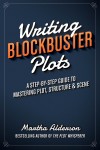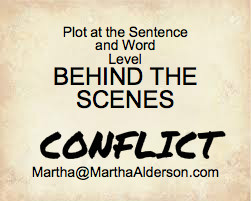Welcome to Step 3 of Behind the Scenes – Scene Types. As I explained in my introductory blog post Resurrect that Novel for a new program I’m developing — Behind the Scenes, designed as a final check for plot at the word level — we’re analyzing both:


1) the words within each scene, testing for the 7 essential elements of plot in each scene using my newest book Writing Blockbuster Plots
2) the scenes by identifying each scene type with the help of Writing Deep Scenes
Behind the Scenes – Emotion (Step #1) and Behind the Scenes – Conflict (Step #2) we use the Scene Tracker as developed in Writing Blockbuster Plots as the starting place to analyze plot, at the word level.
Now, using the scenes you’ve analyzed, identify each scene type.
RECAP OF STEPS #1 & #2
I found the first 2 steps in Behind the Scenes, evaluating and improving each verb and each section containing significant emotional change in every scene, tedious and extremely rewarding.
Having focused on ensuring that every scene contain emotional ups and downs, I’d never spent much time evaluating the demonstration of those same emotional moments. Slicing open and exposing the character’s most intimate internal emotional repertoire revealed non-verbal, visceral indications of emotion could be deepen and much further developed. Taking the time needed to capture just the right nonverbal communication to convey the exact right emotion allowed me, and ultimately my readers, so much nearer to the characters, their motivations and demons.
Using the strategies in the 1st two steps of the program, I’ve reached the End of the Beginning /No Turning Back Energetic Marker. Now I’m ready to evaluate the scene types that make up that 1st Energetic Marker. (For loads of scene examples showing how all 15 Scene Types are used in award-winning stories, read Writing Deep Scenes.)
SCENE TYPES
Told from alternating points-of-view chapters of two major characters, my story has two separate No Turning Back Markers — one for each protagonist at the 1/4 mark in their own individual plot line and tied together thematically.
- Female Protagonist Energetic Marker #1
- As we explain in Writing Deep Scenes — Energetic Markers are often made up of clusters of scenes building up to that one break-off moment.
- For my story, one scene only creates the End of the Beginning or No Turning Back moment
- As we also explain in Writing Deep Scenes using a combination of scene types at major moments in your story like at the Energetic Markers often creates more power and intensity than one scene type alone.
- In my story, the one scene that makes up the 1st Energetic Marker for the female protagonist is a combination of a Twister scene and a Suspense scene
- As we explain in Writing Deep Scenes — Energetic Markers are often made up of clusters of scenes building up to that one break-off moment.
- Male Protagonist Energetic Marker #1
- One scene only makes up the End of the Beginning or No Turning Back moment
- That one scene that makes up the 1st Energetic Marker for the male protagonist is a combination of a Escape scene and a Suspense scene
Going through the bullet-points for each scene type (from Writing Deep Scenes) I accessed small yet powerful tweaks, lending more strength to this most pivotal turning point in the beginning portion of my final draft.
Example
- Though Escape scenes are more commonly found in the middle and ending scenes, the male protagonist is in need of escape at the end of the beginning. I hadn’t considered injecting a “clicking clock” or time constraint in this scene. By doing so, the scene takes on an even greater sense of urgency.
- In looking for ways in to inject even more of a sense of unpredictably in the female protagonist’s antagonist at the 1st Energetic Marker, I found a great character trait I hadn’t considered for her major antagonist, one that adds more thematic depth.
Awareness of all types of scenes allows you to strengthen the elements that may not come naturally or intuitively to you. Plot is made up of action. Learn the great action scenes at your disposal, like suspense and twister and escape, and you too will be writing Page-Turning plots!
* * * *
![Pageflex Persona [document: PRS0000026_00034]](https://marthaalderson.com/wp-content/uploads/2016/08/Paralell-Lives-FULL-0815-300x224.jpg)
Parallel Lives demonstrates that our chances for love and happiness are never truly over or used up. Success hangs on readiness and timing.
Buy Parallel Lives ((A Novel)) today!

 Behind the Scenes — Conflict
Behind the Scenes — Conflict
Follow Me!